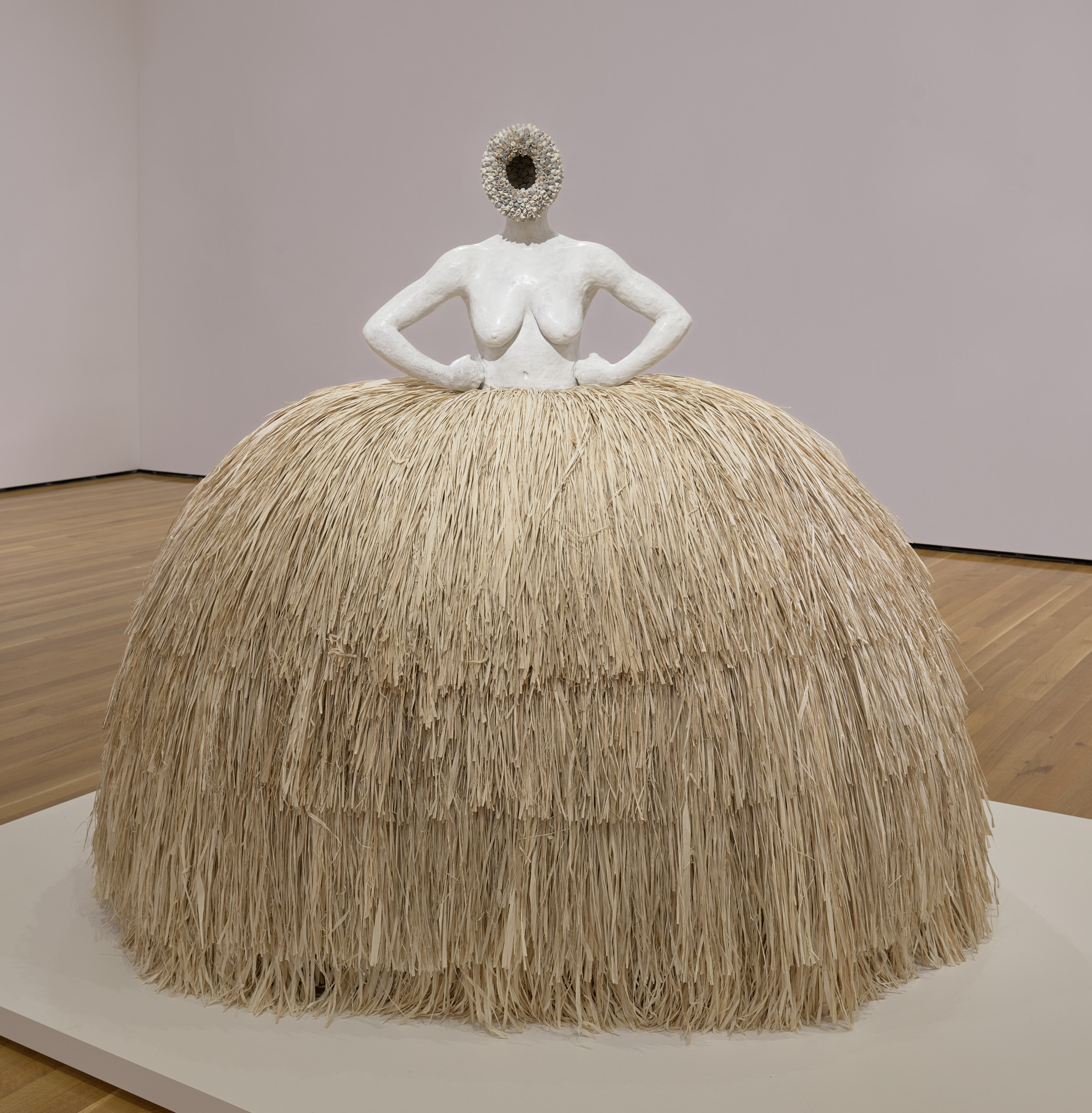
- Magazine Article
- Collection
Simone Leigh
The artists' Las Meninas, acquired last year, invites examination of the relationship between artist, subject, and viewer

At six feet high, Simone Leigh’s sculpture Las Meninas (2019) strikes an imposing presence in the museum’s contemporary galleries. The female figure is nude from the waist up and stands with hands positioned at the sides. The raffia skirt that extends from her waist is almost as wide as she is tall, and the dried, grasslike material extends down in tiers to the floor. However, the expressive nature of the figure’s pose is not reflected in her face. Instead, viewers are met with a void, a gaping hole at the front of the sculpture’s head. The faceless head is lined on the inside and out with tiny, delicate porcelain rosettes or shell-like forms that range in hue from white to light pink to pastel green. The rosettes are a recurring motif in Leigh’s practice, and reference the female body. Indeed, every element of Las Meninas, from the terracotta body to the raffia skirt, points to Leigh’s ongoing engagement with the ceramic medium and the Black female body.
Born in 1967 in Chicago to Jamaican parents, Leigh now lives and works in New York. Nearly three decades ago, the artist’s first job in New York was at an architectural ceramics firm where she reproduced tiles for the subway. Since that time, Leigh has embraced ceramics as her primary sculptural medium, using it to explore the experiences and social histories of Black women.
“When I was in college studying philosophy and cultural studies, I remember being really taken with the works that I saw photographed in a book called Nigerian Pottery,” she says, “and it led me to think about the anonymous labor of women and the way African objects and material culture are categorized. I continue to be interested in these sorts of things. I think of Black women and femmes as a kind of material culture.”
In this way, the skirt that forms the base of Las Meninas is in part a reference to a large ceramic vessel. In other versions of life-size skirted figures, Leigh affixes a handle to one side of the skirt to reinforce this visual parallel.
As the title Las Meninas suggests, the skirted form evokes Spanish artist Diego Velázquez’s 1656 painting of the young Infanta Margaret Theresa surrounded by her entourage. The enigmatic painting is a touchstone in Western art history, as it includes a self-portrait of the artist. The central infanta figure, shown wearing a voluminous, tiered skirt and assuming an erect stance, is reflected in this sculpture by Leigh, raising complex questions about the relationship between artist, subject, and viewer, while inviting viewers to similarly think beyond the represented figure to contemplate what elements are hidden “just below the surface” of an artwork.
While Leigh’s skirted form evokes Velázquez’s infanta, it also refers to the Afro-Brazilian religious tradition candomblé and the architecture of Mousgoum communities in Cameroon. Historically, candomblé was brought to the Americas by enslaved Africans, and it developed into a syncretic religion that draws from both Christian and West African sources. Music and dance are integral elements of candomblé religious ceremonies, and in referencing these practices, Leigh sought to capture the pageantry and agency of candomblé dancers. The skirt’s raffia material, ubiquitous throughout Leigh’s artwork, also conjures traditional African masks, which have long been a visual touchstone for the artist.

Leigh has spoken about the joy of making large-scale works, her hands becoming the fine tools to shape the pliable medium. The surface of the CMA sculpture’s torso was contoured by the artist’s hands. The surface of the figure’s arms, breasts, and back retain clear evidence of Leigh’s touch, as they are not perfectly smooth but hold the bumps and divots of her working and shaping the clay with her palms and fingers.
The thick, white glaze that covers the terracotta torso of Las Meninas adds another layer of texture. While it has been applied over the entire surface of the torso, on close inspection one can see the terracotta underneath in some areas. The white glaze was inspired by sacred and secular traditions of body-painting, especially the use of white powder in Haitian ancestral rituals to access the dead, and the use of white clay in South Africa to guard skin from the sun. As Leigh puts it, she was drawn to a material that has connotations of both communication and protection.
Las Meninas is a standout work in Leigh’s oeuvre: it shows the artist’s mastery of materials and motifs she has honed over time, while exemplifying the power of scale she has recently begun to embrace for its capacity to endow her figures with a bold and majestic presence. Las Meninas was acquired through the Sundry Contemporary Art Fund, generously donated by CMA Board of Trustees President Scott Mueller, and is currently on view in the contemporary galleries. By acquiring this sculpture, the Department of Contemporary Art has meaningfully added to its holdings of art by women and by African American artists, both of which are collecting priorities. The work is especially fitting for the CMA’s encyclopedic collections because it exemplifies Leigh’s use of global art traditions and culture to address issues surrounding the female body, race, beauty, and community.
Cleveland Art, Fall 2020